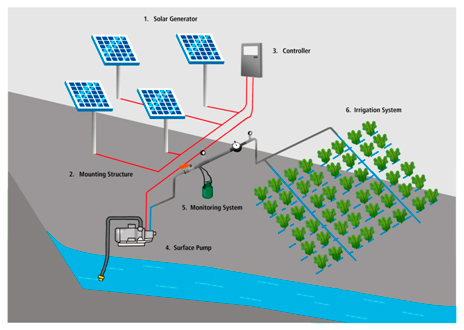Difference between revisions of "SPIS Toolbox - Select SPIS Configuration"
***** (***** | *****) (Created page with "<div> = Select SPIS configuration = </div> <br/> A SPIS can be designed in many ways; major variations will lie in the combination of key components: *solar mounting system ...") |
***** (***** | *****) |
||
| Line 19: | Line 19: | ||
The figure below shows an SPIS configuration where one saves on the costs for the reservoir but spends on the tracking systems. The tracking system enables a relatively stable pump dis-charge which is important, because there is no reservoir to buffer the amount of water going to the field. The water can further be controlled by the valves and by splitting up of the drip irrigation systemin sections. | The figure below shows an SPIS configuration where one saves on the costs for the reservoir but spends on the tracking systems. The tracking system enables a relatively stable pump dis-charge which is important, because there is no reservoir to buffer the amount of water going to the field. The water can further be controlled by the valves and by splitting up of the drip irrigation systemin sections. | ||
| − | [[File:Configuration-solar.jpg|thumb| | + | [[File:Configuration-solar.jpg|thumb|center|600px|SPIS configuration with a solar tracking system, surface pump and drip irrigation]] |
Revision as of 13:06, 12 May 2017
Select SPIS configuration
A SPIS can be designed in many ways; major variations will lie in the combination of key components:
- solar mounting system (fixed or tracking);
- motor pump installation (submersible or surface);
- integration of a reservoir or not;
- irrigation method – mainly drip or surface irrigation.
An overview and description of different configurations of the individual components is provided in the GET INFORMED module.
Technically, any irrigation method can be combined with a solar water pump. However, it becomes a matter of cost. Pressure and high discharge require more energy and therefore higher costs. Drip irrigation, working at comparably low operating pressures and water efficient, suits solar pumping systems best. Yet, it requires that the producer learns new irrigation management skills. The suitability of a particular system configuration for a given farm depends on the water availability, the farm’s specific water requirements, its agricultural production and the producer’s skills and budget.
The human and financial resources required for maintenance should already be considered in the design of the system. As a rule, higher investments in good quality equipment outweigh the time and effort put into maintaining and repairing poor quality equipment.
The figure below shows an SPIS configuration where one saves on the costs for the reservoir but spends on the tracking systems. The tracking system enables a relatively stable pump dis-charge which is important, because there is no reservoir to buffer the amount of water going to the field. The water can further be controlled by the valves and by splitting up of the drip irrigation systemin sections.




















